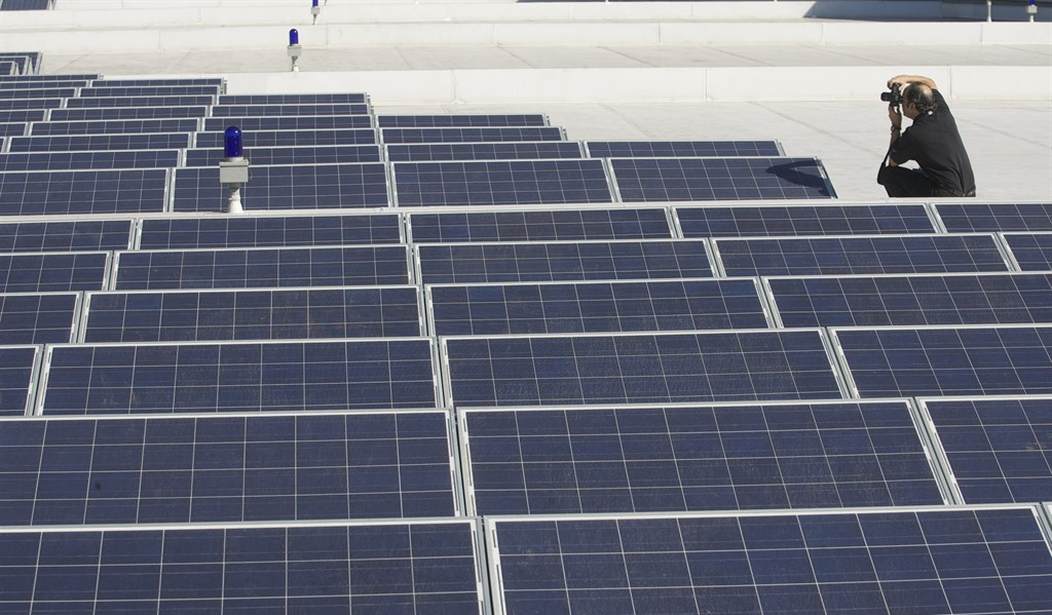Democrats love green energy but mostly because it allows them to put on the air that they’re somehow far more environmentally conscious than their opponents and thus if you’re concerned about the future of the planet and thus mankind, voting for them is the only way to save the world.
The truth is actually a lot more political. Democrats will do things that hurt the environment if it gives off the impression that they’re helping it. For instance, the claim that the Keystone XL Pipeline is damaging isn’t proven, and in fact, leaks from the pipeline are far less damaging and risky to the environment than the transportation of crude oil via truck or train. That’s not to mention the amount of CO2 that wouldn’t be pumped into the air through the vehicles transporting the oil from Canada into America.
But let’s take a look at the “environmentally safe” options Democrats keep saying are going to save our planet and see just how good for the environment they are.
Let’s start with solar farms. According to Sciencing, solar farms do a great deal of harm to the environment they’re placed in including harm to wildlife and environment degradation:
In order to provide a significant amount of electrical energy, solar farms require large tracts of land. Western states like California have deserts with abundant space and sunshine, but these areas are also natural habitats that support wildlife. For example, environmental reports underestimated the number of desert tortoises that would be displaced by the Ivanpah Solar Generating System in California’s Mojave Desert. The same solar farm also came under scrutiny when an increasing number of bird deaths were reported on its premises. Many of their wings had been melted or burned off by heat from the solar farm’s mirrors.
…
The impact that solar farms have on individual species can send ripples throughout entire ecosystems. For example, animals like burrowing owls in California’s Mojave Desert rely on burrows dug by desert tortoises for shelter (See Reference 4). When solar farms harm or remove species within a habitat, they also remove the valuable ecosystem services that they provide to the habitat. The habitat becomes less livable for plants and wildlife that have adapted to its specific conditions.
Also is the issue cadmium, an element that is used in the construction of solar panels that is highly toxic according to OSHA:
Cadmium and its compounds are highly toxic and exposure to this metal is known to cause cancer and targets the body’s cardiovascular, renal, gastrointestinal, neurological, reproductive, and respiratory systems.
Michael Shellenberger, founder of Environmental Progress wrote at Forbes that the amount of waste that solar panels produce would surprise you. The cadmium in the solar panels can be washed out by rainwater, poisoning the soil where the farm exists. That’s not to mention the issues with disposing of old or broken solar panels as Shellenberger writes:
Solar panels often contain lead, cadmium, and other toxic chemicals that cannot be removed without breaking apart the entire panel. “Approximately 90% of most PV modules are made up of glass,” notes San Jose State environmental studies professor Dustin Mulvaney. “However, this glass often cannot be recycled as float glass due to impurities. Common problematic impurities in glass include plastics, lead, cadmium and antimony.”
Researchers with the Electric Power Research Institute (EPRI) undertook a study for U.S. solar-owning utilities to plan for end-of-life and concluded that solar panel “disposal in “regular landfills [is] not recommended in case modules break and toxic materials leach into the soil” and so “disposal is potentially a major issue.”
Wind energy isn’t much better. Researchers at the U.S. Geological Survey found troubling data when it came to wind turbines’ ability to output power, noting that the output was 100 times lower than expected and that wind farms tend to generate far less energy due to the effects it has on the wind in the area according to SciTechDaily:
What was missing from this previous research, however, were observations to support the modeling. Then, a few months ago, the U.S. Geological Survey released the locations of 57,636 wind turbines around the U.S. Using this data set, in combination with several other U.S. government databases, Keith and postdoctoral fellow Lee Miller were able to quantify the power density of 411 wind farms and 1,150 solar photovoltaic plants operating in the U.S. during 2016.
“For wind, we found that the average power density — meaning the rate of energy generation divided by the encompassing area of the wind plant — was up to 100 times lower than estimates by some leading energy experts,” said Miller, who is the first author of both papers. “Most of these estimates failed to consider the turbine-atmosphere interaction. For an isolated wind turbine, interactions are not important at all, but once the wind farms are more than five to 10 kilometers deep, these interactions have a major impact on the power density.”
The wind and solar farms that need to exist to a great degree to meet energy demands would mean the demolishing of a lot of lands in order to make it useable for this renewable energy. This means the destruction of a lot of habitat for the animals in the area.
While this is all very destructive, what may not surprise you is that many of these renewable energy sources contain ingredients and elements that cannot be found in the United States, specifically rare-earth metals. Know where they can be found?
China.
As Jazz Shaw at Hot Air wrote on the matter, much of the rare-Earth metals needed to construct solar panels is found in China, and pushing for these solar panels, as the Biden administration is doing with great abandon, would indebt us to China by a great deal:
But the bigger crisis we’re looking at with the Green New Deal has to do with our ability to actually manufacture all the equipment required to generate that kind of energy. A new report from Leiden University in the Netherlands reveals one factor that progressives don’t seem to have considered. Expanding production of solar and wind power facilities is going to require a vastly larger supply of what are known as “rare-earth metals” like neodymium, terbium, dysprosium, and praseodymium. Here’s the problem. The current global supply of these metals is nowhere near the anticipated demand and the countries that control most of those supplies aren’t exactly our best friends.
It’s not just the expense of constructing so many solar panels, it’s who we’d have to end up paying that should worry you more.















